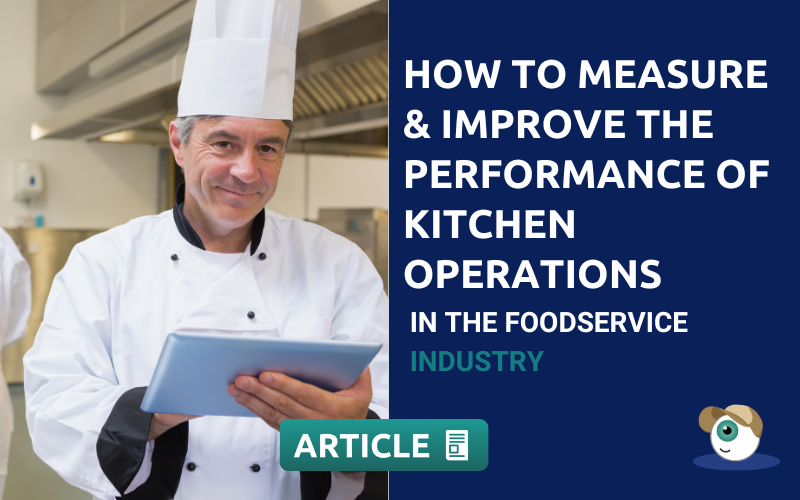How to Measure and Improve the Performance of Kitchen Operations in the Foodservice Industry

The food service industry thrives on efficiency and consistency.
Customers expect their orders to be accurate, prepared quickly, and delivered with exceptional quality and safety.
To achieve this level of service, food service businesses need a robust system for measuring and improving kitchen operations.
In this article, we explore which key performance indicators (KPIs) are vital for assessing kitchen performance, continuous improvement practices like Kaizen, and the role of Andy’s auditing tool in measuring and enhancing kitchen operations.
Key Performance Indicators (KPIs) for Measuring Kitchen Performance in the Food Service Sector
KPIs are quantifiable metrics that provide valuable insights into the effectiveness of kitchen operations.
Here are some key metrics to consider when studying kitchen performance:
Order Accuracy
Order accuracy is a critical KPI that measures the correctness of orders delivered to customers. High order accuracy reflects well on the kitchen’s efficiency and directly impacts customer satisfaction. Inaccurate orders can lead to customer complaints, increased waste, and additional costs.
Preparation Time
Preparation time refers to the time taken from when an order is received until it is ready for delivery. Reducing preparation time without compromising quality is essential for improving customer satisfaction and increasing table turnover rates in restaurants. Efficient preparation processes can also help in managing peak hours more effectively.
Food Cost Percentage
This measures the cost of food ingredients as a percentage of total sales. Tracking food cost helps optimise inventory management and control unnecessary expenses.
Labour Cost Percentage
This measures the cost of labour as a percentage of total sales. Analysing labour costs helps optimise staffing levels and improve operational efficiency.
Customer Satisfaction
Customer satisfaction is a broad KPI that can be measured through feedback surveys, online reviews, and direct customer interactions. High levels of customer satisfaction indicate that the kitchen operations are meeting or exceeding customer expectations in terms of food quality, service speed, and overall dining experience.
Waste Management
Effective waste management measures the amount of food and material waste generated in the kitchen. Reducing waste through better inventory management, portion control, and recycling can significantly cut costs and contribute to environmental sustainability.
Food Waste
This measures the amount of edible food that is thrown away. Minimising food waste reduces costs and promotes sustainability.
Inventory Turnover Rate
This measures how quickly a restaurant sells through its inventory. A high turnover rate indicates efficient inventory management and reduced risk of spoilage.
Temperature Control
This measures the internal temperature of cooked and chilled foods to ensure food safety standards are met.
Number of Health Code Violations
This metric tracks incidents where the kitchen fails to comply with health code regulations.
Food Quality and Consistency
This KPI involves monitoring the taste, presentation, and portion sizes of dishes to ensure they meet the restaurant’s standards consistently. Variability in food quality can deter repeat customers and harm the restaurant’s reputation.
Food Safety and Hygiene
KPIs in this area include regular compliance checks with health regulations, proper food storage, and handling practices. Any lapses can lead to severe consequences, including foodborne illnesses and legal issues.
Staff Efficiency and Productivity
Staff efficiency and productivity can be measured by tracking the number of orders handled per staff member, shift patterns, and time taken to complete specific tasks. Efficient staff utilisation ensures smooth kitchen operations and helps in managing labour costs.
By continuously monitoring these KPIs, restaurants can identify areas for improvement and implement strategies to achieve operational excellence.
Continuous Improvement Practices: The Kaizen Approach
Kaizen, a Japanese term meaning “continuous improvement,” is a powerful methodology for driving ongoing enhancements in kitchen operations.
It involves making small, incremental changes regularly rather than large-scale transformations.
The Kaizen approach focuses on improving processes, reducing waste, and enhancing productivity.
Here’s how Kaizen can be applied in the foodservice industry:
Involving All Employees
Kaizen encourages participation from all employees, from kitchen staff to management. By fostering a culture of continuous improvement, everyone contributes ideas for enhancing operations, leading to a more collaborative and engaged workforce.
Identifying and Eliminating Waste
Kaizen practices help identify and eliminate waste in various forms, such as excess inventory, time delays, and inefficient processes. Streamlining operations ensures smoother workflows and cost savings.
Standardising Processes
Standardising processes ensures that tasks are performed consistently, leading to more predictable and reliable outcomes. It also helps in training new employees more effectively and maintaining high standards of operation.
Standardising Recipes
Develop and implement standardised recipes to ensure consistency in taste, portion size, and preparation time.
Implementing Small Changes Regularly
Rather than waiting for significant issues to arise, Kaizen focuses on making small, continuous improvements. This proactive approach prevents problems from escalating and keeps the kitchen running efficiently.
Equipment Maintenance
Regularly maintain and calibrate kitchen equipment to ensure optimal performance and minimise downtime.
Open Communication
Encourage open communication between kitchen staff and management to address issues and identify opportunities for improvement.
Data-Driven Decision Making
Utilise data from KPIs to guide strategic decisions about menu items, staffing levels, and inventory management.
Enhancing Kitchen Operations with Andy’s Auditing Tool
Regular kitchen audits are crucial for maintaining high standards of operation, quality, and safety, as well as for ensuring that the “continuous improvement” advocated by Kaizen practices is achieved.
Traditional auditing methods can be time-consuming and prone to human error. However, Andy’s digital auditing tool offers a more efficient and accurate way to conduct kitchen audits:
- Comprehensive Checklists: Andy’s auditing tool provides customisable checklists tailored to specific kitchen operations. These checklists cover all critical areas, including food safety, hygiene, equipment maintenance, and operational procedures. Ensuring that all necessary tasks are performed correctly and consistently.
- Real-Time Monitoring and Reporting: Andy allows for real-time monitoring and reporting of kitchen operations. Managers can track compliance with standards and identify any deviations promptly. This real-time visibility enables quicker corrective actions, reducing the risk of non-compliance and improving overall efficiency.
- Enhanced Accountability: With digital audits, every task and inspection is logged and time-stamped. This level of detail enhances accountability among staff, as it is clear who is responsible for each task. It also simplifies follow-up actions and ensures that issues are resolved promptly.
- Data-Driven Insights: Andy’s auditing tool collects and analyses data from each audit, providing valuable insights into kitchen performance. These insights help identify trends, recurring issues, and areas for improvement. Data-driven decision-making leads to more effective strategies for enhancing kitchen operations.
- Simplified Compliance: Staying compliant with health and safety regulations is crucial for any food service business. Andy’s auditing tool simplifies compliance by ensuring that all necessary checks are performed and documented. It also provides easy access to audit records in case of inspections or audits by external bodies.
- Continuous Improvement: By regularly auditing kitchen operations with Andy’s tool, businesses can continuously identify areas for improvement. The tool supports the Kaizen approach by facilitating regular reviews and encouraging incremental improvements. This continuous feedback loop ensures that the kitchen operations are always evolving and improving.
Measuring and improving kitchen operations in the food service industry requires a comprehensive approach that includes monitoring key performance indicators, adopting continuous improvement practices like Kaizen, and leveraging digital tools for efficient auditing.
By focusing on order accuracy, preparation time, customer satisfaction, and other relevant KPIs, businesses can gain valuable insights into their kitchen performance. Continuous improvement practices help maintain high standards, while digital tools like Andy’s auditing tool streamline the auditing process and provide actionable data for ongoing enhancements.
If you haven’t yet, 👉🏽START YOUR ANDY FREE TRIAL TODAY 👈🏽 and ensure that your kitchen operations are optimised, leading to better performance, higher customer satisfaction, and overall operational excellence.

